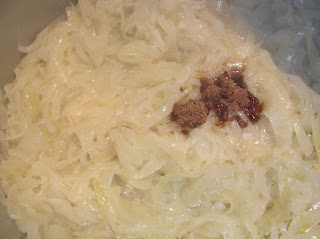Edith Piaf is the soundtrack extra-or-dee-naire for French Onion soup, so please start the video and follow along. ;-)
Onion soup reaches back to the early Roman’s but the version we make today dates from France in the 1700’s. The peasants lived on this stuff because the ingredients are so cheap.
Besides seven or eight large onions, the only other ingredients that are essential are beef broth, stale bread, a bit of cheese and plenty of time.
Luckily the WesternBEEF is piled high in meaty, inexpensive beef bones. Pull a cork, pour some red and arrange them on a flat roasting sheet. If you roast them a bit first they bring a nice, chary flavor.
A bit of salt, a liberal grind of pepper and keep an eye on them at about 375°F until they look like this:
Don’t forget to deglaze your roasting sheet with a bit of water and add it to your broth.
You know the drill by now, put the roasted bones into a big pot, cover them with cold water, add parsley stems and the ends of the onions as you cut them, pour some red wine in and bubble those bones slowly for an hour.
Add a beef bouillon cube if you want, it’s mostly just salt and caramel anyway. Bubble it down to about a gallon. Now slice your onions fairly evenly while you melt half a stick of butter in a thick bottom pot. We’re gonna soften the onions.
I used a whole bag of yellow onions and one sweet vidalia. Put ‘em in the butter and toss to coat them, then turn the heat way down and simmer them slowly, uncovered for awhile.
It looks like a lot of onion but don’t worry, they cook down a lot. Sauteéing them uncovered allows the moisture to cook off, and it concentrates the complex flavors of the sugar in the onion.
Turn them frequently as they soften so they don’t burn, and mix in a teaspoon or so of brown sugar to help them caramelize.
Now keep stirring and sauteéing, they’ll get softer and smaller, and gently darker in color.
Eventually they’ll begin to brown into the most delicious sludge ever, the color of a walnut. Great. So far so good. Turn them off.
Has it been an hour or so? Time to strain your beef stock.
I like to strain it through ever finer meshes until it is clear and free of particles. The bones, by the way, are delicious. Boiled beef has been a staple in the UK since forever.
Add a few cups of hot stock to your onions, stir to loosen them, then pour in the rest and turn on the heat again. You should have four or five quarts. Simmer the soup gently covered for about another hour, adding salt or pepper if you wish. As it gets closer to finished, I add a half cup or so of good cognac.
Now comes the fun part. Ladle some of the soup into a ramekin or an ovenproof crock and fit it with a toasted crouton.
A round cut of a French baguette toasted works great, just fit it and shove it in. Cover it with a good gruyère, like a compté.
Oh boy. :-)
Now into the broiler until the cheese melts, then bubbles and browns. Those peasants may not be rich but their favorite soup sure is.





















































